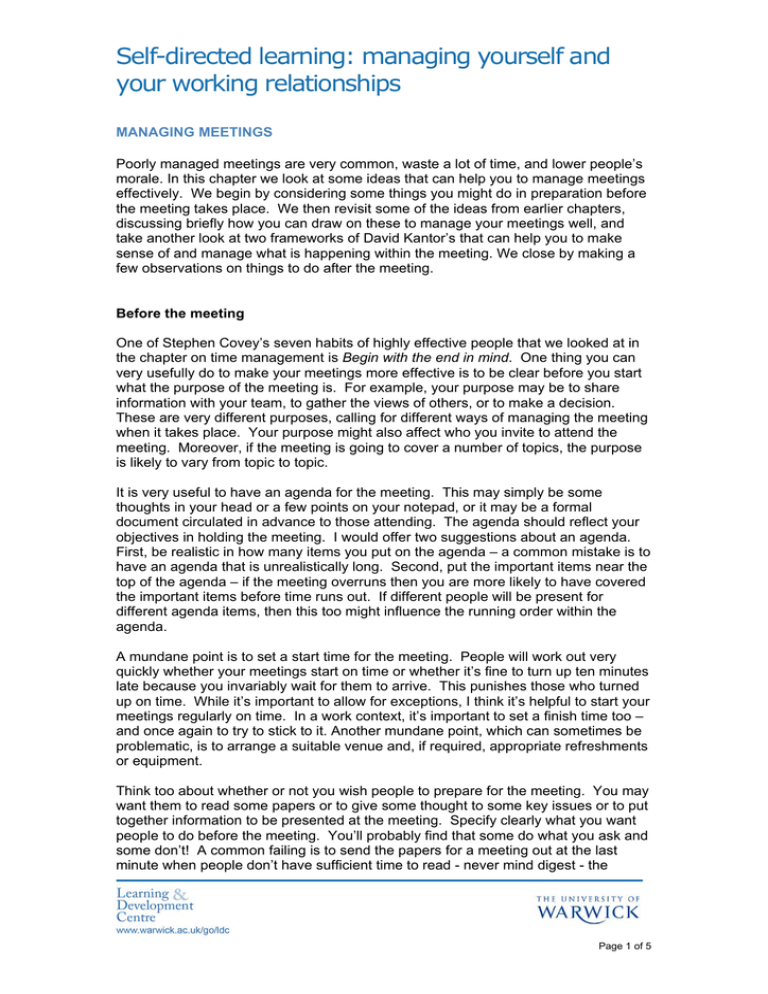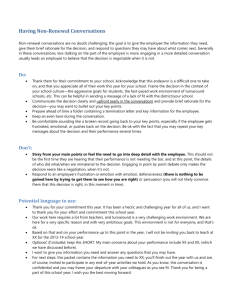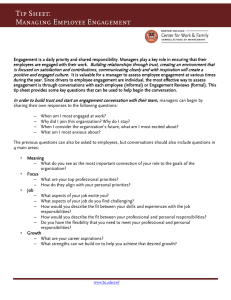Self-directed learning: managing yourself and your working relationships
advertisement

Self-directed learning: managing yourself and your working relationships MANAGING MEETINGS Poorly managed meetings are very common, waste a lot of time, and lower people’s morale. In this chapter we look at some ideas that can help you to manage meetings effectively. We begin by considering some things you might do in preparation before the meeting takes place. We then revisit some of the ideas from earlier chapters, discussing briefly how you can draw on these to manage your meetings well, and take another look at two frameworks of David Kantor’s that can help you to make sense of and manage what is happening within the meeting. We close by making a few observations on things to do after the meeting. Before the meeting One of Stephen Covey’s seven habits of highly effective people that we looked at in the chapter on time management is Begin with the end in mind. One thing you can very usefully do to make your meetings more effective is to be clear before you start what the purpose of the meeting is. For example, your purpose may be to share information with your team, to gather the views of others, or to make a decision. These are very different purposes, calling for different ways of managing the meeting when it takes place. Your purpose might also affect who you invite to attend the meeting. Moreover, if the meeting is going to cover a number of topics, the purpose is likely to vary from topic to topic. It is very useful to have an agenda for the meeting. This may simply be some thoughts in your head or a few points on your notepad, or it may be a formal document circulated in advance to those attending. The agenda should reflect your objectives in holding the meeting. I would offer two suggestions about an agenda. First, be realistic in how many items you put on the agenda – a common mistake is to have an agenda that is unrealistically long. Second, put the important items near the top of the agenda – if the meeting overruns then you are more likely to have covered the important items before time runs out. If different people will be present for different agenda items, then this too might influence the running order within the agenda. A mundane point is to set a start time for the meeting. People will work out very quickly whether your meetings start on time or whether it’s fine to turn up ten minutes late because you invariably wait for them to arrive. This punishes those who turned up on time. While it’s important to allow for exceptions, I think it’s helpful to start your meetings regularly on time. In a work context, it’s important to set a finish time too – and once again to try to stick to it. Another mundane point, which can sometimes be problematic, is to arrange a suitable venue and, if required, appropriate refreshments or equipment. Think too about whether or not you wish people to prepare for the meeting. You may want them to read some papers or to give some thought to some key issues or to put together information to be presented at the meeting. Specify clearly what you want people to do before the meeting. You’ll probably find that some do what you ask and some don’t! A common failing is to send the papers for a meeting out at the last minute when people don’t have sufficient time to read - never mind digest - the Page 1 of 5 Self-directed learning: managing yourself and your working relationships information sent. You also need to master your own briefs too before the meeting – make sure you’ve done your own preparation and reading! Another thing to consider in advance of a meeting is whether you wish to influence some of the participants so that they support the case that you wish to make. Think about the individuals who will be attending, their priorities, and any tensions between different parties. It is generally better to lobby people, to bargain and, if you can, to resolve differences before the meeting takes place than to have the meeting dissolve into argument and conflict. Note, however, that there may be occasions when the purpose of the meeting is to explore and attempt to resolve differences. During the meeting In the chapter on coaching we looked at the coaching dance where as a manager you are moving between telling, on the one hand, and listening and questioning, on the other. And in the chapter on managing people we looked at the Tannenbaum and Schmidt continuum which listed seven styles of leadership which ranged from the manager simply announcing a decision at one end to letting the team decide what to do at the other. Similarly, when you are chairing a meeting it’s very helpful to be clear whether you are announcing a decision you have made, passing on information, arguing for a position you hope will prevail, genuinely consulting to listen to the views or ideas of others, or facilitating a conversation where you are relaxed about what specific decision emerges from the discussion. Note that meetings can be a very inefficient way of passing on information, which often is better disseminated in advance of a meeting or in one-to-one conversations. To make an obvious point, meetings are conversations. The key abilities that we looked at in the chapter on conversations – listening to understand, asking open questions to stimulate thinking or gather views, playing back your understanding of people’s positions, and voicing your own thoughts assertively together with the reasons behind them – are all valuable skills to help you manage meetings well. If you are in the chair at a meeting then you are managing the process as well as seeking to accomplish the purpose of the meeting. You need to attend to the dynamics of the group – which can be a major task in itself. I think it is hard to be facilitating the discussion of an agenda item when at the same time you are arguing strongly for a particular position. One thing you might do in this situation is to ask one of the other participants to take the chair for this item. A key aspect of managing the process is managing the time, balancing appropriate discussion of an agenda item with moving forward to cover the items further down the agenda. The agenda itself is a useful guide to help you to keep the meeting on track. As we saw in the chapter on conversations, playing back what has been said can be a very effective way of managing a conversation. Summarising a discussion or repeating explicitly a decision taken or action point agreed is a useful way of signalling that it’s time to finish one item and move on to the next. It’s important too not to let the discussion drift back to items that have been satisfactorily covered earlier in the meeting – or to engage in discussion of items which appear later on in the agenda. Page 2 of 5 Self-directed learning: managing yourself and your working relationships You are also trying to balance the contribution of different people, which may mean explicitly inviting someone who is inexperienced or lacking in confidence to contribute and which may also mean limiting the air time taken by more verbose individuals. Handling people who speak lengthily or who drift off the point is often easier said than done! On some occasions it may be sufficient to play back accurately your understanding of someone’s position, enabling the discussion to move on. But there may be times when you have to be very firm, possibly stating explicitly that you wish to hear from others or to move on to the next item on the agenda. This calls for sensitivity as there is a risk of damaging relationships. In Effective Leadership Christopher Achua and Robert Lussier note the following five types of problem member that you may find in your meeting: • • • • • Silent – which means that the group does not benefit from their input Talker – who has something to say about everything, and may seek to dominate the conversation Wanderer – who changes the subject and distracts the group from the agenda items Bored – who is not interested or is preoccupied with something else, and who may feel superior Arguer – who enjoys arguing for the sake of arguing, rather than constructively criticising, and may be seeking attention They warn against embarrassing, intimidating or arguing with problematic group members in front of the group. Rather, you need to confront serious problem members individually outside of the meeting. If you are chairing or leading a meeting with the team that you manage, this may be one of the main opportunities you have to establish and maintain your credibility with the team and to manage your relationships with the individuals within the team. As we saw in the chapter on managing people, you are balancing the needs of the task, the team and the individuals. Knowledge of the Myers-Briggs Personality Type profiles of each team member can help you to manage the conversation. For example, you might wish to draw out the Introverts or rein in the Extraverts. Or you might seek to balance some people’s needs for detail or planning with other’s needs for flexibility. And so on. You will be greatly helped when you are leading a meeting if those attending are skilled at being an effective participant. If each of them takes care to prepare for the meeting, is able to listen with an open mind and to put forward their views clearly and assertively, and is willing to accept decisions and to take responsibility for carrying out any actions assigned to them, then your job as chair becomes infinitely easier. You might also like to consider how skilled you are when you are a participant in, rather than the chair of, a meeting. As you can see, there are a lot of aspects to think about when managing a meeting. One thing which may help you is to ask someone else to take notes of the meeting, which relieves you of one task. It’s important obviously to choose someone whom you can trust to keep up with the discussion and to record decisions accurately. As we shall consider in the final section, the notes or minutes of a meeting can be important documents which affect what happens next. In more formal situations, it is Page 3 of 5 Self-directed learning: managing yourself and your working relationships vital to have a Secretary to the meeting who is competent, trustworthy and whom you can work effectively with. It is important at the end of the meeting or as the meeting unfolds to make clear what decisions have been taken, and who is responsible – and by when - for any actions that have been agreed. Two frameworks of David Kantor In the chapter on conversations we also looked at two ideas of David Kantor that are very relevant to managing meetings. The first is the notion that people speak in one of three languages – in his terminology, the language of power, of meaning, and of affect. In particular, people who speak the language of power are comfortable making decisions and agreeing actions. Those who speak the language of meaning or of affect find it much more difficult to address the question What are we going to do? If the purpose of the meeting or agenda item is to make a decision, then you need at the appropriate time to focus everyone’s attention on this. David Kantor’s second framework, the four player system, describes four stances that people may take in a conversation. For a meeting to fully explore an issue all four stances need to be played, usually by different people. • • • • Someone needs to initiate a move, by making a proposal or suggesting an action. For moves to be built upon and developed, someone has to follow by offering support. To avoid simply going with the first idea put forward or blindly following the wishes of the boss, it is important at times for someone to oppose by challenging, hopefully constructively, what is being said or proposed. From time to time it can be very helpful for someone to bystand by making a comment on the process of the meeting – for instance, by noting the passage of time, or by pointing out when people are simply repeating points they have already made. If you regularly chair a meeting of your team or a committee, for example, then it is worth reflecting on which of these roles are generally missing from the conversation. After the meeting As noted earlier, the minutes of a meeting are sometimes very important. In many situations, a simple list of action points – who will do what and by when – is sufficient. Moreover, producing minutes which are a list of action points takes far less time than minutes which record the different views expressed in a discussion. My own preference when I have to write minutes or notes of a meeting is to do this as soon as possible after the meeting, ideally immediately afterwards. I find that leaving it for a few days means that it takes me far longer to make sense of my notes and to remember some of the details. Circulating a list of actions a day or two after a meeting gives people more time to carry out the actions that they are responsible for. Page 4 of 5 Self-directed learning: managing yourself and your working relationships Depending on the situation, you may leave it to whoever took the notes to circulate these, or you may wish carefully to control what is issued. Another aspect to consider after a meeting is follow up conversations. You may need to pacify, reassure or encourage someone who has been upset by what took place. You may need to have a word with someone whose behaviour or contributions were unhelpful. Or you may need to offer practical support to someone to whom an important task has been assigned. Page 5 of 5



